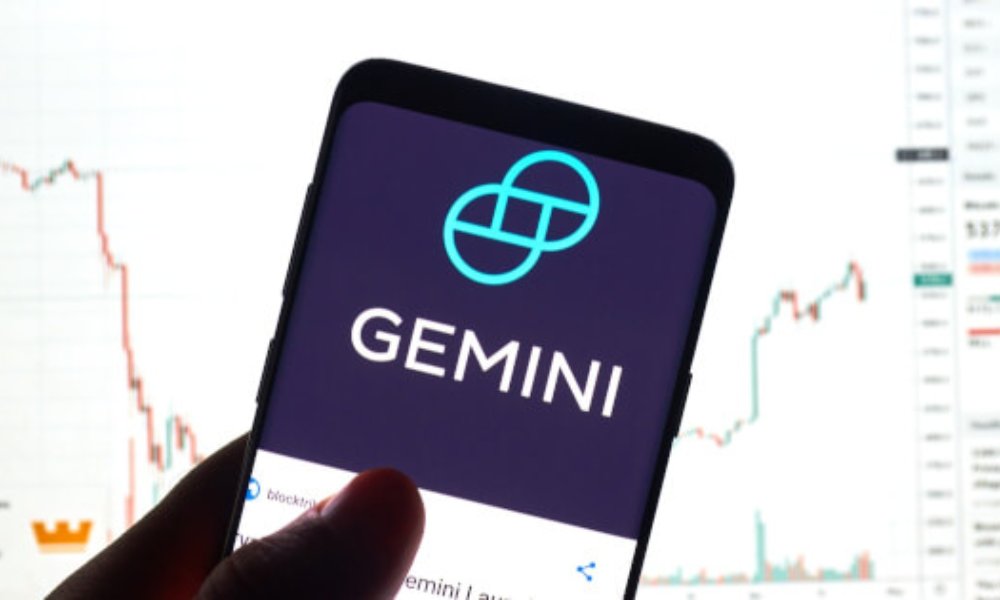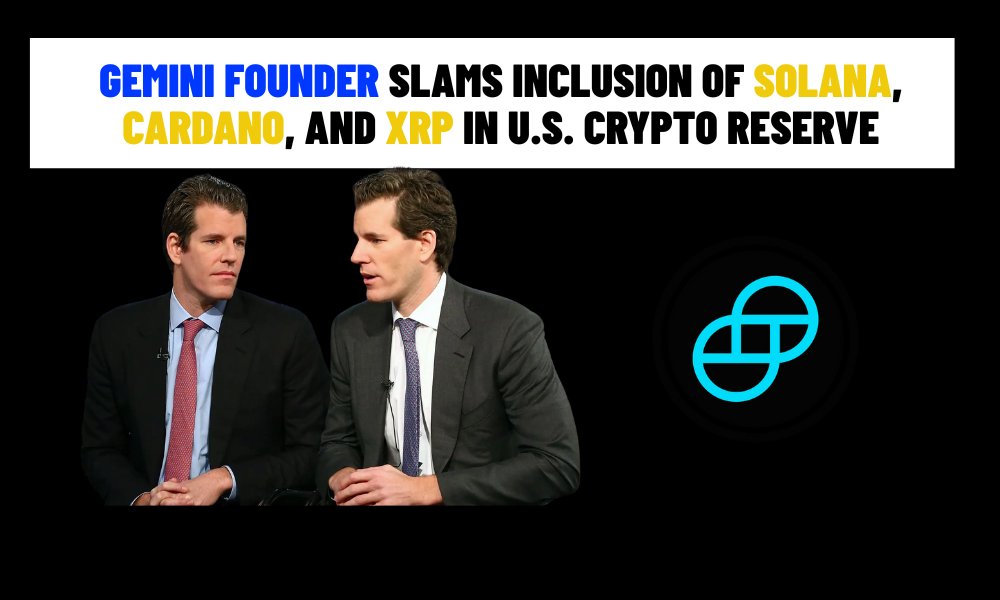On March 3, 2025, Tyler Winklevoss, co-founder and CEO of Gemini, publicly criticized President Donald Trump’s decision to include Solana (SOL), Cardano (ADA), and XRP in the U.S. Strategic Crypto Reserve, alongside Bitcoin (BTC) and Ethereum (ETH). In a fiery post on X, Winklevoss argued that only Bitcoin meets the criteria for a strategic reserve, dismissing the altcoins as unsuitable.
The announcement, which sparked heated debates within the crypto community, reflects broader tensions about the role of digital assets in national financial strategy. Here’s an in-depth analysis of Winklevoss’s stance, the motivations behind Trump’s selections, and the market implications of this controversial move.
Winklevoss’s Bitcoin-Centric Argument
Tyler Winklevoss’s criticism centers on his belief that Bitcoin is the only digital asset with the maturity, decentralization, and reliability to serve as a strategic reserve. In his X post, he stated, “I have nothing against XRP, SOL, or ADA, but I do not think they are suitable for a Strategic Reserve. Only one digital asset in the world right now meets the bar, and that digital asset is Bitcoin.” He emphasized Bitcoin’s unique attributes—its fixed 21 million supply, proof-of-work consensus, and global adoption—as unmatched among cryptocurrencies.
Winklevoss’s stance aligns with Bitcoin maximalists, who view BTC as the ultimate store of value, akin to “digital gold.” He echoed sentiments from industry leaders like Michael Saylor, who called Bitcoin the “foundation” of the crypto economy after the reserve announcement. Critics of altcoins, including Winklevoss, argue that SOL, ADA, and XRP lack Bitcoin’s proven track record, citing concerns about centralization, regulatory risks, and market volatility. For instance, XRP’s association with Ripple, which faces ongoing SEC scrutiny, and Solana’s past network outages are often cited as vulnerabilities.’

Trump’s Strategic Crypto Reserve: A Bold and Controversial Move
President Trump’s announcement on March 2, 2025, outlined a Strategic Crypto Reserve that includes Bitcoin, Ethereum, Solana, Cardano, and XRP, using assets seized from criminal activities. The reserve aims to position the U.S. as a leader in the digital economy, with Trump touting SOL, ADA, and XRP as “high-potential” assets for future growth. A separate “Digital Asset Portfolio” will allow the government to stake, restructure, or sell these altcoins, while Bitcoin is prioritized for long-term holding.
The inclusion of altcoins has sparked speculation about political and financial motives. Analyst Alex Xu from Mint Ventures suggested that Solana, Cardano, and XRP were chosen due to their financial ties to Trump’s campaign and supporting funds, raising questions about impartiality. Notably, Binance Coin (BNB), despite its $86 billion market cap, was excluded, prompting a response from Binance founder Changpeng Zhao, who urged calm and predicted future inclusions. Trump’s team, including advisor David Sacks, clarified that the selections were based on market capitalization, though discrepancies—such as BNB ranking higher than ADA—have fueled skepticism.
Community and Industry Pushback
The decision to include altcoins drew sharp rebuttals from project leaders and investors. Charles Hoskinson, Cardano’s founder, defended XRP’s inclusion, calling it “a stellar technology, a global standard, surviving multiple brutal cycles for over a decade with a strong community.” He dismissed Winklevoss and critic Peter Schiff’s skepticism, emphasizing Cardano and XRP’s resilience. Solana’s co-founder, Anatoly Yakovenko, also pushed back, denying rumors of lobbying for inclusion and arguing that government-controlled reserves undermine crypto’s decentralized ethos.
Other industry voices, including Coinbase CEO Brian Armstrong and Texas Blockchain Council’s Lee Bratcher, echoed Winklevoss, advocating for a Bitcoin-only reserve due to its unmatched decentralization. Conversely, investors celebrated the altcoin inclusions, with posts on X from users like @Justin_Bons hailing the move as a victory for “superior alternative blockchains” and a blow to Bitcoin maximalism. The market responded enthusiastically: Cardano surged 60% in 24 hours, overtaking Dogecoin in market cap, while Bitcoin climbed past $94,000, and Ethereum rose 19%.
Market Impact and Volatility
The reserve announcement triggered significant price movements. XRP jumped 35.51% in two days, briefly hitting $3 before correcting to $2.38 by March 3, reflecting a 5.2% drop in 24 hours. Solana and Cardano also saw double-digit gains, driven by speculative fervor, though volatility persisted. The broader crypto market, with a $2.73 trillion cap, faced a 4% correction by April 16, 2025, as investors took profits amid macroeconomic concerns, including U.S. trade tariffs and Federal Reserve policy uncertainty.
Analysts warn that the reserve’s success hinges on Congressional approval, with JPMorgan’s Nikolaos Panigirtzoglou estimating less than a 50% chance of passage. He argued that including altcoins beyond Bitcoin and Ethereum could face resistance due to regulatory and financial complexities. The market’s initial excitement has waned, with XRP and Cardano dropping 2–5% by mid-April, signaling a cautious investor outlook.

Broader Implications and Regulatory Context
Trump’s reserve reflects a seismic shift in U.S. crypto policy, building on 2025’s pro-crypto legislative momentum. States like Kentucky and Texas have passed Bitcoin-friendly laws, and the administration’s proposal for a Federal Strategic Bitcoin Reserve has spurred 23 states to consider similar measures, potentially injecting $23 billion into crypto markets. The SEC’s recent openness to altcoin ETFs, including filings for XRP, Solana, and Cardano, further supports mainstream adoption, though approvals remain pending.
However, the inclusion of altcoins raises questions about centralization and government influence. Critics like Yakovenko argue that state-controlled reserves could erode crypto’s core value of decentralization. Winklevoss’s Bitcoin-only stance may also reflect Gemini’s strategic interests, as the exchange heavily promotes BTC trading and recently integrated XRP into its algo trading lineup alongside SOL and ETH.
Risks and Future Outlook
The Strategic Crypto Reserve faces several risks:
-
Congressional Pushback: Lawmakers may resist altcoin inclusions, favoring a Bitcoin-centric reserve, as suggested by JPMorgan’s analysis.
-
Market Volatility: Altcoins’ price swings, as seen with XRP’s rapid rise and fall, could undermine the reserve’s stability.
-
Regulatory Scrutiny: XRP’s unresolved SEC lawsuit and Solana’s technical vulnerabilities may complicate their reserve status.
-
Political Bias Concerns: Allegations of campaign finance ties to SOL, ADA, and XRP could erode public trust.
Looking ahead, the reserve’s fate will depend on upcoming discussions, including a White House conference on March 7, 2025, to finalize details. If approved, the reserve could legitimize crypto as a national asset class, driving institutional adoption. For investors, altcoin ETFs and reserve-related price catalysts offer opportunities, but caution is warranted given regulatory and market uncertainties.
A Polarizing Step Toward Crypto Legitimacy
Tyler Winklevoss’s critique of Solana, Cardano, and XRP’s inclusion in the U.S. Strategic Crypto Reserve highlights deep divisions in the crypto community over which assets deserve prominence. While Trump’s bold move signals a pro-crypto era, it has ignited debates about decentralization, political influence, and financial strategy. As markets react and Congress deliberates, the reserve’s outcome will shape the future of digital assets in the U.S. and beyond. For now, Bitcoin remains the focal point, but the altcoins’ role in this historic experiment will be closely watched by investors and innovators alike.
